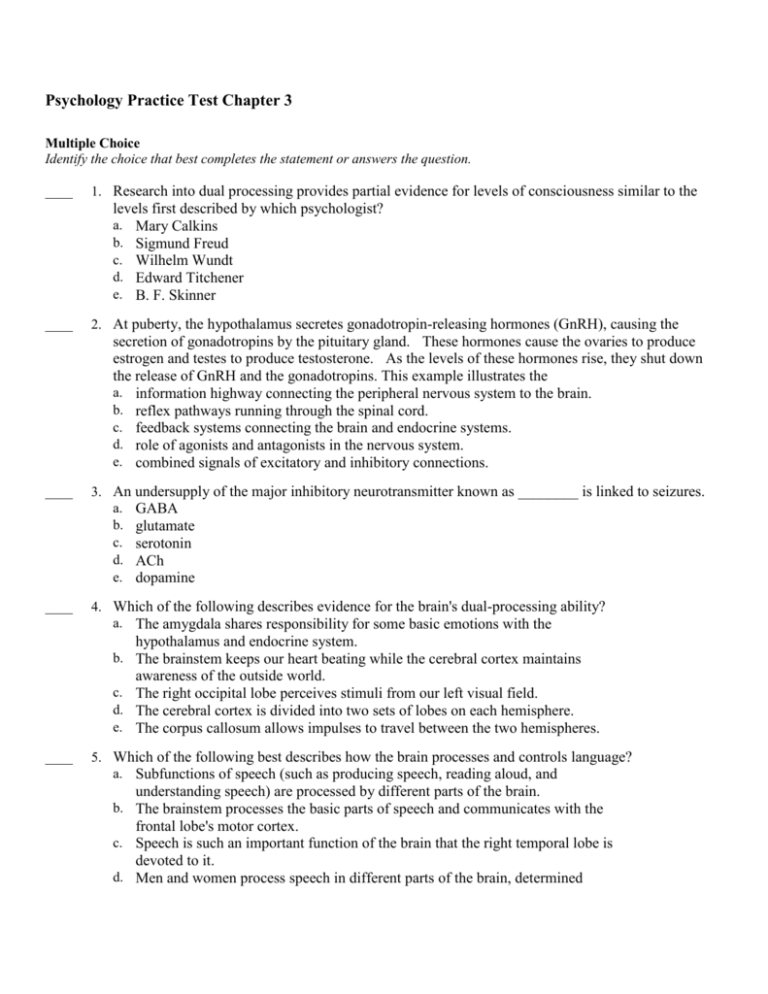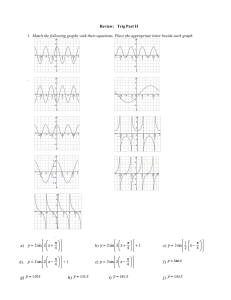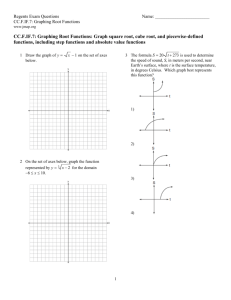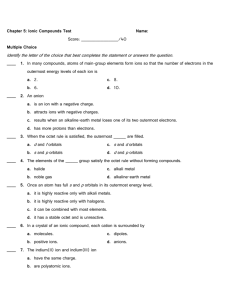Psychology Practice Test Chapter 3
advertisement

Psychology Practice Test Chapter 3 Multiple Choice Identify the choice that best completes the statement or answers the question. ____ 1. Research into dual processing provides partial evidence for levels of consciousness similar to the levels first described by which psychologist? a. Mary Calkins b. Sigmund Freud c. Wilhelm Wundt d. Edward Titchener e. B. F. Skinner ____ 2. At puberty, the hypothalamus secretes gonadotropin-releasing hormones (GnRH), causing the secretion of gonadotropins by the pituitary gland. These hormones cause the ovaries to produce estrogen and testes to produce testosterone. As the levels of these hormones rise, they shut down the release of GnRH and the gonadotropins. This example illustrates the a. information highway connecting the peripheral nervous system to the brain. b. reflex pathways running through the spinal cord. c. feedback systems connecting the brain and endocrine systems. d. role of agonists and antagonists in the nervous system. e. combined signals of excitatory and inhibitory connections. ____ 3. An undersupply of the major inhibitory neurotransmitter known as ________ is linked to seizures. a. GABA b. glutamate c. serotonin d. ACh e. dopamine ____ 4. Which of the following describes evidence for the brain's dual-processing ability? a. The amygdala shares responsibility for some basic emotions with the b. c. d. e. ____ hypothalamus and endocrine system. The brainstem keeps our heart beating while the cerebral cortex maintains awareness of the outside world. The right occipital lobe perceives stimuli from our left visual field. The cerebral cortex is divided into two sets of lobes on each hemisphere. The corpus callosum allows impulses to travel between the two hemispheres. 5. Which of the following best describes how the brain processes and controls language? a. Subfunctions of speech (such as producing speech, reading aloud, and understanding speech) are processed by different parts of the brain. b. The brainstem processes the basic parts of speech and communicates with the frontal lobe's motor cortex. c. Speech is such an important function of the brain that the right temporal lobe is devoted to it. d. Men and women process speech in different parts of the brain, determined primarily by genetics and early environmental conditions. e. Speech is primarily controlled in the occipital lobes, although association areas in the parietal lobes are also involved. ____ 6. What are the molecules that are similar enough to a neurotransmitter to bind to its receptor sites on a dendrite and mimic that neurotransmitter's effects called? a. agonists b. antagonists c. action potentials d. endocrines e. endorphins ____ 7. Evolutionary psychologists would be most likely to attribute gender differences in attitudes toward sex to the fact that men have ________ than do women. a. greater reproductive potential b. a weaker sense of empathy c. stronger personalities d. more insecurities e. larger bodies ____ 8. The concentration of glucose in active regions of the brain underlies the usefulness of a(n) a. MRI. b. brain lesion. c. EEG. d. PET scan. e. hemispherectomy. ____ 9. Botulin is a poison with a molecular structure so similar to acetylcholine (ACh) that it blocks the effects of ACh in synapses, making botulin which kind of molecule? a. agonist b. endocrine c. autonomic d. antagonist e. endorphin ____ 10. Gender differences in heritable personality traits cannot necessarily be attributed to male-female genetic differences because a. males and females are also affected by their different sex hormones. b. physical maturation proceeds at a different rate for males and females. c. chromosomal adaptation has not been accounted for. d. variations in personality contribute to gender differences. e. heritable traits can be influenced by social environments. ____ 11. A picture of a cat is briefly flashed in the left visual field and a picture of a mouse is briefly flashed in the right visual field of a split-brain patient. The individual will be able to use her a. left or right hand to indicate she saw a cat. b. left hand to indicate she saw a mouse. c. right hand to indicate she saw a mouse. d. right hand to indicate she saw a cat. e. left or right hand to indicate she saw a mouse. ____ 12. The ability to recognize faces with the right hemisphere but not with the left hemisphere best illustrates a. neurogenesis. b. aphasia. c. lateralization. d. Parkinson's disease. e. plasticity. ____ 13. When the “Jim twins,” identical twins separated at birth, were reunited 38 years later, surprising similarities were discovered. Although they had married women of the same name, named their sons and dogs the same names, one should be cautious before attributing these similarities to genetic factors because a. the Jim twins were raised in completely different environments. b. genes influence physical not psychological characteristics. c. many fraternal twins show greater psychological differences. d. any two strangers are likely to share coincidental similarities. e. most twin studies have not been replicated. ____ 14. The occipital lobes are to ________ as the temporal lobes are to ________. a. sensing pleasure; sensing pain b. seeing; hearing c. seeing; sensing touch d. speaking; hearing e. hearing; sensing movement ____ 15. Molecules that are similar enough to a neurotransmitter to bind to its receptor sites on a dendrite and block that neurotransmitter's effects are called what? a. antagonists b. endorphins c. endocrines d. action potentials e. agonists ____ 16. After he suffered a stroke, Mr. Santore's physical coordination skills and responsiveness to sensory stimulation quickly returned to normal. Unfortunately, however, he began to experience unusual difficulty figuring out how to find his way to various locations in his neighborhood. It is most likely that Mr. Santore suffered damage to his a. hypothalamus. b. cerebellum. c. autonomic nervous system. d. association areas. e. thalamus. ____ 17. Which lobes of the brain receive the input that enables you to feel someone scratching your back? a. occipital b. c. d. e. temporal cerebral. parietal frontal ____ 18. The medulla is to the control of ________ as the cerebellum is to the control of ________. a. eating; sleeping b. emotion; motivation c. breathing; walking d. hearing; seeing e. memory; attention ____ 19. An undersupply of serotonin is most closely linked to a. schizophrenia. b. euphoria. c. Alzheimer's disease. d. depression. e. Parkinson's disease. ____ 20. Alzheimer's disease is most closely linked to the deterioration of neurons that produce a. endorphins. b. glutamate. c. epinephrine. d. dopamine. e. acetylcholine. ____ 21. A person whose hand had been amputated actually felt sensations on his nonexistent fingers when his face was stroked. This best illustrates the consequences of a. lateralization. b. hemispherectomy. c. aphasia. d. brain plasticity. e. tomography. ____ 22. The region of your cerebral cortex that enables you to recognize a person as your own mother is a. an association area. b. Wernicke's area. c. the limbic system. d. Broca's area. e. the angular gyrus. ____ 23. An all-or-none response pattern is characteristic of the a. activation of either the sympathetic or the parasympathetic system. b. release of hormones into the bloodstream. c. excitation of the antagonistic hormonal system. d. initiation of neural impulses. e. release of endorphins into the central nervous system. ____ 24. If Professor Kosiba lesions the amygdala of a laboratory rat, the rat will most likely become a. b. c. d. e. hungry. physically uncoordinated. less aggressive aphasib. sexually aroused. ____ 25. People can simultaneously process many aspects of sensory information such as color, shape, and size. This best illustrates the functioning of multiple a. neural networks. b. ACh agonists. c. dendrites. d. ACh antagonists. e. endorphins. ____ 26. Which of the following fictional research findings is the best evidence against the idea that “our lives are determined by our experiences”? a. The political opinions of adopted children are closer to those of their adopted parents than those of their biological parents. b. Babies are born with personalities that are relatively stable throughout their lives. c. Extremely stressful experiences can change overall optimistic explanatory styles into more pessimistic styles. d. Reinforcements, like praise from caregivers, are the most powerful motivator for most children. e. IQ scores can change drastically (more than one standard deviation) after children are provided enriched environments. ____ 27. A football quarterback can simultaneously make calculations of receiver distances, player movements, and gravitational forces. This best illustrates the activity of multiple a. neural networks. b. endorphin antagonists. c. thresholds. d. endorphin agonists. e. endocrine glands. ____ 28. Two plants are grown under the same environmental conditions, including the same soil conditions and the same amount of light and water, but one grows to 2 feet tall and the other is 1 foot tall. In this case, the heritability would be closest to a. 95 percent. b. 5 percent. c. 50 percent. d. 25 percent. e. 80 percent. ____ 29. Evolutionary psychologists would be most likely to predict that a. more people are biologically predisposed to fear guns than to fear snakes. b. children are more likely to be valued by their biological fathers than by their stepfathers. c. people are the most romantically attracted to those who are the most genetically dissimilar to themselves. d. environmental influences are more deterministic than genetic influences. e. genetic predispositions have little effect on our social relationships. ____ 30. Some opiate drugs have molecular structures so similar to endorphins that they mimic endorphin's euphoric effects in the brain, making these opiate drugs which kind of molecule? a. autonomics b. antagonists c. endocrines d. endorphins e. agonists ____ 31. Information travels from the spinal cord to the brain via a. the sympathetic nervous system. b. sensory neurons. c. interneurons. d. the endocrine system. e. the circulatory system. ____ 32. What is the main difference between an MRI scan and an fMRI scan? a. MRI scans measure brain wave activity, fMRI scans use a series of X-ray images to show structural details. b. MRI scans measure glucose levels in the brain, fMRI scans measure oxygen levels. c. MRI scans show structural details of the brain, fMRI scans show structure and activity levels. d. MRI scans use X-rays, fMRI scans use gamma rays. e. MRI scans are able to show internal structures of the brain, fMRI scans can also show external structures. ____ 33. At the age of 22, Mrs. LaBlanc was less than 4 feet tall. Her short stature was probably influenced by the lack of a growth hormone produced by the a. pituitary gland. b. thyroid. c. myelin. d. adrenal gland. e. pancreas. ____ 34. In a recent car accident, Tamiko sustained damage to his right cerebral hemisphere. This injury is most likely to reduce Tamiko's ability to a. solve arithmetic problems. b. understand simple verbal requests. c. facially express emotions. d. process information in an orderly sequence. e. control his aggression. ____ 35. The process of anticipating that you will be punished for misbehaving takes place within the a. sympathetic nervous system. b. association areas. c. limbic system. d. reticular formation. e. sensory cortex. ____ 36. Animal research has revealed a general reward system that triggers the release of the neurotransmitter a. epinephrine. b. GABA. c. dopamine. d. serotonin. e. ACh. ____ 37. The genome is the complete a. range of traits that contribute to reproductive success. b. set of interactions between genes and environments. c. set of genetic material in an organism's chromosomes. d. collection of sexual characteristics regulated by the X and Y chromosomes. e. collection of genetic and hormonal influences on behavior. ____ 38. Which of the following fictional research findings is the best evidence against the idea that “biology is destiny”? a. Cognitive therapy can help people change unwanted personality traits. b. Early humans gradually developed aversions to bitter-tasting foods because many poisons were bitter. c. Women have larger and more active brain structures than men. d. Testosterone levels are associated with incarceration rates. e. Babies are born with the ability to turn away from frightening stimuli. ____ 39. After Kato's serious motorcycle accident, doctors detected damage to his cerebellum. Kato is most likely to have difficulty a. playing his guitar. b. experiencing intense emotions. c. tasting the flavors of foods. d. understanding what others are saying. e. reading printed words. ____ 40. The parietal lobes are to ________ as the occipital lobes are to ________. a. sensing pleasure; sensing pain b. sensing touch; seeing c. hearing; speaking d. tasting; smelling e. speaking; seeing ____ 41. After a car swerves in front of you on the highway, you notice that your heart is still racing, even though you know you are no longer in danger. Why do the physical symptoms of fear linger even after we cognitively realize the danger has passed? a. Excitatory neurotransmitters travel faster than inhibitory neurotransmitters. b. The parasympathetic nervous system is less effective than the sympathetic nervous system. c. Dopamine controls fear, and this chemical takes a certain amount of time to break down in your system. d. Endocrine messages tend to outlast the effects of neural messages. e. The adrenal glands tend to act more quickly than the rest of the endocrine system. ____ 42. One function of the glial cells is to a. control heartbeat and breathing. b. stimulate the production of hormones. c. mimic the effects of neurotransmitters. d. provide nutrients to interneurons. e. control the muscle movements involved in speech. ____ 43. Chromosomes are located within human a. unconscious. b. gender schemas. c. neurotransmitters. d. bone cells. e. genes. Psychology Practice Test Chapter 3 Answer Section MULTIPLE CHOICE 1. ANS: B DIF: Difficult REF: Page 90 | Section- Biological Bases of Behavior: 3B—The Brain OBJ: 10 TOP: The brain and consciousness 2. ANS: C DIF: Difficult REF: Page 63 | Section- Biological Bases of Behavior: 3A—Neural Processing and the Endocrine System OBJ: 6 TOP: The endocrine system 3. ANS: A DIF: Difficult REF: Page 57 | Section- Biological Bases of Behavior: 3A—Neural Processing and the Endocrine System OBJ: 4 TOP: How neurotransmitters influence us (TableA 3.1) 4. ANS: B DIF: Difficult REF: Page 90 | Section- Biological Bases of Behavior: 3B—The Brain OBJ: 10 TOP: The brain and consciousness 5. ANS: A DIF: Difficult REF: Page 80 | Section- Biological Bases of Behavior: 3B—The Brain OBJ: 6 TOP: The cerebral cortex: Language 6. ANS: A DIF: Difficult REF: Page 57 | Section- Biological Bases of Behavior: 3A—Neural Processing and the Endocrine System OBJ: 4 TOP: How drugs and other chemicals alter neurotransmission 7. ANS: A DIF: Difficult REF: Page 106 | Section- Biological Bases of Behavior: 3C—Genetics-Evolutionary Psychology-and Behavior OBJ: 6 TOP: Natural selection and mating preferences 8. ANS: D DIF: Difficult REF: Page 68 | Section- Biological Bases of Behavior: 3B—The Brain OBJ: 1 TOP: The tools of discovery 9. ANS: D DIF: Difficult REF: Page 58 | Section- Biological Bases of Behavior: 3A—Neural Processing and the Endocrine System OBJ: 4 TOP: How drugs and other chemicals alter neurotransmission 10. ANS: E DIF: Difficult REF: Page 100 | Section- Biological Bases of Behavior: 3C—Genetics-Evolutionary Psychology-and Behavior OBJ: 3 TOP: Heritability: group differences 11. ANS: C DIF: Difficult REF: Page 85 | Section- Biological Bases of Behavior: 3B—The Brain OBJ: 8 TOP: Splitting the brain 12. ANS: C DIF: Difficult REF: Page 83 | Section- Biological Bases of Behavior: 3B—The Brain OBJ: 8 TOP: Splitting the brain 13. ANS: D DIF: Difficult REF: Page 98 | Section- Biological Bases of Behavior: 3C—Genetics-Evolutionary Psychology-and Behavior OBJ: 2 TOP: Twin and adoption studies 14. ANS: B DIF: Difficult REF: Page 74 | Section- Biological Bases of Behavior: 3B—The Brain OBJ: 4 TOP: Structure of the cortex 15. ANS: A DIF: Difficult 16. 17. 18. 19. 20. 21. 22. 23. 24. 25. 26. 27. 28. 29. 30. 31. REF: Page 58 | Section- Biological Bases of Behavior: 3A—Neural Processing and the Endocrine System OBJ: 4 TOP: How drugs and other chemicals alter neurotransmission ANS: D DIF: Difficult REF: Page 79 | Section- Biological Bases of Behavior: 3B—The Brain OBJ: 5 TOP: Association areas ANS: D DIF: Difficult REF: Page 74 | Section- Biological Bases of Behavior: 3B—The Brain OBJ: 4 TOP: Structure of the cortex ANS: C DIF: Difficult REF: Page 69 | Section- Biological Bases of Behavior: 3B—The Brain OBJ: 2 TOP: The brainstem ANS: D DIF: Difficult REF: Page 57 | Section- Biological Bases of Behavior: 3A—Neural Processing and the Endocrine System OBJ: 4 TOP: How neurotransmitters influence us (TableA 3.1) ANS: E DIF: Difficult REF: Page 57 | Section- Biological Bases of Behavior: 3A—Neural Processing and the Endocrine System OBJ: 4 TOP: How neurotransmitters influence us (TableA 3.1) ANS: D DIF: Difficult REF: Page 82 | Section- Biological Bases of Behavior: 3B—The Brain OBJ: 7 TOP: The brain's plasticity ANS: A DIF: Difficult REF: Page 79 | Section- Biological Bases of Behavior: 3B—The Brain OBJ: 5 TOP: Association areas ANS: D DIF: Difficult REF: Page 55 | Section- Biological Bases of Behavior: 3A—Neural Processing and the Endocrine System OBJ: 2 TOP: Neurons ANS: C DIF: Difficult REF: Page 71 | Section- Biological Bases of Behavior: 3B—The Brain OBJ: 3 TOP: The amygdala ANS: A DIF: Difficult REF: Page 61 | Section- Biological Bases of Behavior: 3A—Neural Processing and the Endocrine System OBJ: 5 TOP: The central nervous system ANS: B DIF: Difficult REF: Page 108 | Section- Biological Bases of Behavior: 3C—Genetics-Evolutionary Psychology-and Behavior OBJ: 8 TOP: Reflections on nature and nurture ANS: A DIF: Difficult REF: Page 61 | Section- Biological Bases of Behavior: 3A—Neural Processing and the Endocrine System OBJ: 5 TOP: The central nervous system ANS: A DIF: Difficult REF: Page 101 | Section- Biological Bases of Behavior: 3C—Genetics-Evolutionary Psychology-and Behavior OBJ: 3 TOP: Heritability ANS: B DIF: Difficult REF: Page 105 | Section- Biological Bases of Behavior: 3C—Genetics-Evolutionary Psychology-and Behavior OBJ: 5 TOP: Evolutionary psychology today ANS: E DIF: Difficult REF: Page 57 | Section- Biological Bases of Behavior: 3A—Neural Processing and the Endocrine System OBJ: 4 TOP: How drugs and other chemicals alter neurotransmission ANS: C DIF: Difficult REF: Page 61 | Section- Biological Bases of Behavior: 3A—Neural Processing and the Endocrine System OBJ: 5 TOP: The central nervous system 32. ANS: B DIF: Difficult REF: Page 68 | Section- Biological Bases of Behavior: 3B—The Brain OBJ: 1 TOP: The tools of discovery 33. ANS: A DIF: Difficult REF: Page 63 | Section- Biological Bases of Behavior: 3A—Neural Processing and the Endocrine System OBJ: 6 TOP: The endocrine system 34. ANS: C DIF: Difficult REF: Page 86 | Section- Biological Bases of Behavior: 3B—The Brain OBJ: 8 TOP: Splitting the brain 35. ANS: B DIF: Difficult REF: Page 79 | Section- Biological Bases of Behavior: 3B—The Brain OBJ: 5 TOP: Association areas 36. ANS: C DIF: Difficult REF: Page 73 | Section- Biological Bases of Behavior: 3B—The Brain OBJ: 3 TOP: The hypothalamus 37. ANS: C DIF: Difficult REF: Page 96 | Section- Biological Bases of Behavior: 3C—Genetics-Evolutionary Psychology-and Behavior OBJ: 1 TOP: Genes: Our codes for life 38. ANS: A DIF: Difficult REF: Page 108 | Section- Biological Bases of Behavior: 3C—Genetics-Evolutionary Psychology-and Behavior OBJ: 8 TOP: Reflections on nature and nurture 39. ANS: A DIF: Difficult REF: Page 70 | Section- Biological Bases of Behavior: 3B—The Brain OBJ: 2 TOP: The cerebellum 40. ANS: B DIF: Difficult REF: Page 74 | Section- Biological Bases of Behavior: 3B—The Brain OBJ: 4 TOP: Structure of the cortex 41. ANS: D DIF: Difficult REF: Page 63 | Section- Biological Bases of Behavior: 3A—Neural Processing and the Endocrine System OBJ: 6 TOP: The endocrine system 42. ANS: D DIF: Difficult REF: Page 74 | Section- Biological Bases of Behavior: 3B—The Brain OBJ: 4 TOP: Structure of the cortex 43. ANS: D DIF: Difficult REF: Page 95 | Section- Biological Bases of Behavior: 3C—Genetics-Evolutionary Psychology-and Behavior OBJ: 1 TOP: Genes: Our codes for life









